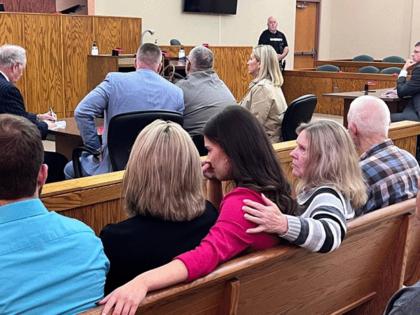Former Kentucky sheriff's deposition in federal case 'crucial' to murder defense, lawyer says
Published in News & Features
LEXINGTON, Ky. — The lawyer representing a former Kentucky sheriff charged with killing a local judge said a deposition given just days before the shooting would play a “crucial” part in the sheriff’s defense.
Jeremy Bartley, the attorney for ex-Letcher County Sheriff Shawn “Mickey” Stines, said Monday that Stines’ deposition in the separate federal case — an investigation of Stines’ office — was just one piece of the story that led to the shooting that rocked the small Eastern Kentucky town of Whitesburg this past fall.
“This is a story in some ways that will be difficult to tell, and more complete to tell,” Bartley said Monday afternoon. “I ask that everyone withhold judgment.
“Let the story be told in the courtroom.”
Stines was arraigned in Letcher County Circuit Court Mondayfor the September fatal shooting of district judge Kevin Mullins. He pleaded not guilty and was denied bond by the presiding judge.
Days before the Sept. 19 shooting in Mullins’ courthouse office, Stines gave a deposition in a case in which he was accused of not properly supervising a deputy who coerced a woman to have sex with him in the judge’s office. A deposition is sworn testimony that parties to a lawsuit solicit from the other side before trial.
Stines was then shown on video shooting and killing the judge. Authorities said the two argued before the shooting, but they have given no other indication of motive.
Monday’s comment was the first official indication that the two incidents may be connected.
What the federal lawsuit alleges
The lawsuit at issue was filed in federal court in January 2022 by a woman who alleged that Ben Fields, then a deputy under Stines, had coerced her into having sex with him in return for letting her avoid paying home incarceration fees.
The woman, Sabrina Adkins, had been in jail but was let out on home incarceration and was required to pay a fee for the monitoring device on her ankle.
Adkins said she didn’t want to have sexual contact with Fields but went along with him because she couldn’t afford the fee and didn’t want to go back to jail.
Fields took Adkins to Mullins’ office in the courthouse for sex several times because there were no cameras in the office, according to the complaint.
A second woman, Jennifer Hill, later joined the lawsuit, alleging that Fields coerced her into having sex with him in his car outside her home by threatening to have her home incarceration revoked.
Fields was a security officer in court, but the lawsuit did not allege that Mullins knew anything about Fields’ actions. It did allege that Stines failed to properly supervise Fields.
Bartley told media after the court proceeding that the federal investigation was a crucial piece of Stines’ defense, but he did not elaborate on exactly how.
Bartley encouraged individuals to avoid the rumors circulating online and on social media.
“That information is just a grain of salt,” Bartley said. “I believe there will be a very complete defense for Stines and we look forward to putting that on for him.”
Stines pleads not guilty, judge denies bond
Throughout the hearing, nearly a dozen law enforcement officials and other security were posted around the room. Family of both Stines and Mullins attended the proceeding.
Judge Julia Adams denied bond for Stines after he pleaded not guilty. Adams said she had previously been inclined to set a bond for Stines, but said Monday she had given more consideration to community safety, a victims’ rights law and that the charge is a capital offense.
Last week, after Stines was indicted, prosecutor Jackie Steele said he continues to oppose bond for Stines.
Stines has been held without bond since the shooting. If he has an ability to post bond, he would be released pending trial. His attorney, Kerri Bartley, said the defense team will plan to file a motion for an adversarial bond hearing.
The indictment accuses Stines of shooting and killing Mullins inside Mullins’ courthouse office on Sept. 19.
Stines, 43, surrendered to other police immediately after the shooting and was initially charged with murder in district court. He has been held in jail since then, and he retired as sheriff less than two weeks after the shooting.
Video of the shooting showed that when Stines pointed his gun at Mullins, the judge raised one hand, as if to ward off the threat, and then turned away from Stines and hunkered over in a defensive position. That’s when Stines shot him the first time, sending Mullins falling to the floor.
Stines then went to the other side of the desk to get a look at Mullins. The judge raised his head, then ducked behind the desk for cover and Stines shot him again, the video showed.
Stines walked quickly to the door and opened it to leave, but then quickly turned toward Mullins, who was on the floor and appeared to still be moving. Stines fired again and then turned and left.
There was no sound in the 24-second video clip, released Oct. 1 at Stines’ preliminary hearing.
At an Oct. 1 hearing in the case, Clayton Stamper, a detective with the Kentucky State Police, testified that Stines tried to call his daughter on Mullins’ phone and on his own phone just before the shooting.
Stamper said Stines stood up from his chair in the judge’s office after looking at Mullins’ phone and shot him seconds later.
Steele said he could not comment on what evidence was presented to the grand jury, including whether the panel saw the video.
The crime could be eligible for the death penalty if Stines is convicted because Mullins was a public official.
Steele, who is prosecuting the case with Attorney General Russell Coleman’s office, said there had been no decision yet on whether to seek the death penalty against Stines if he is convicted.
However, Stines’ attorney, Jeremy Bartley, has said that he does not think the murder is the appropriate charge in the case.
Bartley said at the Oct. 1 hearing that the evidence offered there pointed to the shooting as being an act of “extreme emotional disturbance” in reaction to something Stines had seen on Mullins’ phone.
There was no information at the hearing about what was on the phone.
If a jury decided Stines acted out of extreme emotional disturbance, he couldn’t be convicted of murder, but rather first-degree manslaughter or a lesser crime. The death penalty would not be an option in that case.
Letcher County is a rural, mountain county in the southeast corner of Kentucky, on the Virginia border. It’s about 150 miles from Lexington.
_____
©2024 Lexington Herald-Leader. Visit kentucky.com. Distributed by Tribune Content Agency, LLC.







Comments